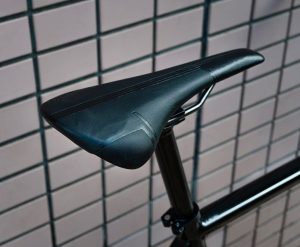
Road bike seat uncomfortable, you’re not alone; many cyclists experience discomfort in this area. The discomfort can be due to various reasons, and there are several steps Why Do Road Bikes Have Uncomfortable Seats you can take to address it:
Why Do Road Bikes Have Uncomfortable Seat
Saddle Fit: The first step is to ensure that your saddle (bike seat) is the right size and shape for your body. Saddles come in different widths and designs, so try to find one that matches your sit bone width. Many bike shops offer saddle fitting services to help you find the right one.
Saddle Height: Proper saddle height is crucial. If your saddle is too low or too high, it can cause discomfort. You should have a slight bend in your knee when your pedal is at its lowest point.
Saddle Tilt: Adjusting the tilt of your saddle can make a significant difference. A level saddle is a good starting point, but you might need to tilt it slightly up or down to find the most comfortable position for you.
Padding: Some saddles come with more or less padding. Consider trying a saddle with more cushioning if you find yours too hard. However, keep in mind that excessively padded saddles can sometimes lead to discomfort as well.
Saddle Position: The fore-aft position of your saddle can also impact comfort. Small adjustments in saddle position can sometimes relieve discomfort.
Cycling Shorts: Invest in high-quality cycling shorts with a padded chamois. The chamois helps to reduce friction and provide additional comfort during rides.
Bike Fit: A professional bike fitting can help address any issues with your bike’s geometry and ensure that it’s properly adjusted to your body.
Riding Technique: Proper riding technique can also make a difference. Make sure you’re not putting excessive pressure on your saddle by leaning too far forward or gripping the handlebars too tightly.
Build Up Tolerance: If you’re new to road biking or haven’t ridden for a while, it can take some time for your body to adjust to the saddle. Gradually increasing your riding time and intensity can help build up tolerance.
Consult a Specialist: If you’ve tried various adjustments and still experience discomfort, consider consulting a bike fit specialist or a healthcare professional. They can provide personalized advice and solutions.
Remember that discomfort is common when you start cycling or when you change your riding habits. It often takes some trial and error to find the right setup that works for you. Additionally, what works for one person may not work for another, so don’t be afraid to experiment and seek expert advice if needed.
Is It Normal For A Bike Seat To Hurt?
Remember that cycling should be an enjoyable and relatively pain-free activity. If you’re experiencing significant discomfort in the saddle area, it’s essential to address the root causes by adjusting your bike setup, trying different saddles, and consulting with professionals if needed to ensure a more comfortable and enjoyable riding experience.
How Long Does It Take To Get Used To Bike Seat Pain?
Getting used to bike seat discomfort or pain can vary from person to person. It depends on several factors, including your individual physiology, the type of saddle you’re using, the amount of time you spend cycling, and your riding posture. Here are some general guidelines:

Initial Discomfort: When you first start cycling or switch to a new saddle, it’s common to experience discomfort, especially if you’re not accustomed to long rides. This initial discomfort can last anywhere from a few days to a few weeks, depending on the factors mentioned above.
Adaptation: Over time, your body will adapt to the pressure points and stress placed on your sit bones. Your muscles and soft tissues in the pelvic region will toughen up, and you’ll become more comfortable on the saddle. This adaptation process can take several weeks to a few months.
Proper Saddle Fit and Adjustment: If you’re experiencing prolonged discomfort, it might indicate that your saddle is not properly fitted to your body or adjusted correctly. Make sure your saddle is the right size and shape for your sit bone width and that it’s positioned at the correct height and angle. Proper adjustment can significantly reduce discomfort and expedite the adaptation process.
Riding Frequency and Duration: The more you ride, the quicker your body will adapt to the bike seat. Consistent and regular riding will help build up your tolerance and reduce discomfort more rapidly.
Cycling Shorts: Wearing cycling shorts with a padded chamois can help reduce discomfort and speed up the adaptation process. The chamois provides additional cushioning and reduces friction.
Saddle Choice: Some saddle designs are more comfortable for certain individuals than others. If you’ve given it enough time and still find the discomfort unbearable, you might want to consider trying a different saddle with a design that suits your body better.
Seek Professional Advice: If you’ve given it a reasonable amount of time and still can’t get used to the discomfort, consider getting a professional bike fitting. A bike fit specialist can assess your riding posture and recommend changes to improve your comfort.
In summary, the time it takes to get used to bike seat discomfort can vary, but most cyclists experience significant improvement within a few weeks to a few months with regular riding and proper saddle adjustment. If the discomfort persists beyond this time frame, it’s a good idea to consult a professional to ensure your bike and saddle are set up correctly and to rule out any underlying issues.
Advantages Of A Road Bike
Road bikes offer several advantages that make them a popular choice for cyclists who prioritize speed, efficiency, and performance on paved roads. Here are some key advantages of road bikes:
Speed and Efficiency: Road bikes are designed for speed. Their lightweight frames, narrow tires, and aerodynamic shapes reduce rolling resistance and make them exceptionally efficient for riding on smooth roads. This allows cyclists to travel faster with less effort.
Lightweight Construction: Road bike frames are typically made from materials like carbon fiber, aluminum, or titanium, known for their lightweight properties. This reduced weight makes it easier to accelerate, climb hills, and maintain higher speeds.
Narrow Tires: Road bike tires are narrower than those on other types of bikes, reducing rolling resistance and increasing speed. The narrow tires also contribute to the bike’s overall aerodynamics.
Drop Handlebars: Road bikes feature drop handlebars that provide multiple hand positions. This allows riders to adjust their posture for comfort and aerodynamics, making it easier to maintain a more streamlined position.
Versatile Gear Range: Road bikes are equipped with a wide range of gears, allowing cyclists to handle various terrains, from steep climbs to flat sprints. This versatility makes them suitable for long-distance rides, hilly terrain, and competitive racing.
Stiff Frames: Road bike frames are designed to be stiff, efficiently transferring power from the pedals to the wheels. This stiffness helps improve acceleration and responsiveness.
Responsive Handling: Road bikes offer precise and responsive handling, allowing riders to make quick and controlled maneuvers. This is essential for navigating through traffic, avoiding obstacles, and taking sharp turns at high speeds.
Comfort Features: While road bikes are built for speed, modern models often include features to enhance rider comfort on long rides. This can include carbon seatposts, padded saddles, and designs that help absorb road vibrations.
Versatility: Road bikes can handle various surfaces, including well-maintained gravel or packed dirt roads. Some road bikes are specifically designed for gravel riding, combining road bike efficiency with off-road capabilities.
Fitness Benefits: Riding a road bike is an excellent way to improve cardiovascular fitness, build leg strength, and burn calories. It provides a low-impact workout that’s gentler on the joints compared to activities like running.
Competitive Racing: Road bikes are the preferred choice for competitive road racing, such as the Tour de France. They are optimized for speed and performance, making them ideal for cyclists looking to compete at a high level.
Customization: Road bikes are highly customizable, allowing riders to choose components like wheels, tires, saddles, and drivetrain components to match their preferences and riding style.
In summary, road bikes are well-suited for cyclists who prioritize speed, efficiency, and performance on paved roads. Whether you’re a competitive racer, a fitness enthusiast, or simply enjoy long road rides, a road bike can provide an exhilarating and efficient riding experience.

Hi my family member I want to say that this post is awesome nice written and come with approximately all significant infos I would like to peer extra posts like this
Thanks you so much
Hi my family member I want to say that this post is awesome nice written and come with approximately all significant infos I would like to peer extra posts like this
Thanks